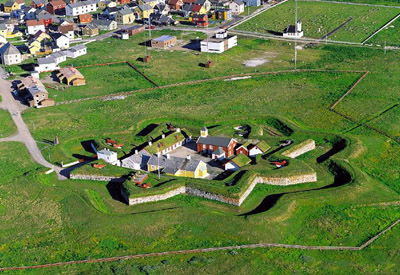 |
Vardøhus Fortress
Vardø, Norway
|
|
 |
Constructed: 1734-1738
Used by: Denmark, Norway
Conflict in which it participated:
Second World War
|
Vardøhus Fortress is not only the world's northernmost starfort, it's the northernmost fortification of any kind!
The first fort built on the tiny island of Vardø was called Varghøya, erected in 1306 at the behest of Norway's King Haakon V (1270-1319). 'Twas built to oversee the fur and fish trade, as well as to keep an eye on the doings of those always dastardly Russians.
A second fort, Østerhågen (East Bay), was constructed on the same spot on Vardø sometime in the last half of the 15th century.
|
 |
|
|
In 1583 Norway's rights to the Arctic Sea were officially recognized by England (why thanks, England!), causing every vessel wishing to enter the White Sea to have to stop at Østerhågen to pay a toll.
|
 Adorable! Adorable! |
 |
Various drastic late-16th-century leapings about betwixt Norway, Russia, Sweden and Denmark brought the area's strategic importance back into focus. Danish King Christian IV (1577-1648) visited Østerhågen in 1599 and ordered its commander to make absolutely certain to continue to collect taxes from passing Russian vessels, despite the Russians' conviction that they should not, since they owned the White Sea; and to be even more certain to deter any Swedes from entering the White Sea at all.
"But this fort is a useless pile of delapidated rubble in this year of 1599," replied the commander, and King Christian IV had to concede the point. |
|
The much-reduced Østerhågen was completely renovated, and served for the next century to solidify Danish control of the region. By the 1730's the fort was again in decrepit condition, and Vardøhus was finally built from 1734 to 1738, and then further upgraded during the Napoleanic Wars (1803-1815).
|
Vardøhus was manned and on active anti-invasion duty during the First World War (1914-1918), but Germany decided it didn't want a godforsaken mass of rocks and coldness, and thus did not invade Lapland.
In the early days of the Second World War (1939-1945), Vardøhus was used as a POW camp, which at one point held 155 captured German naval personnel. It also housed anti-aircraft guns, which engaged in mortal (if seemingly slow-moving) combat with a Luftwaffe bomber on June 4, 1940: The bomber, which had managed to take out Vardøhus' radio hut, was hit with defensive fire and "limped away with a wounded navigator."
|
 |
The rooves of Vardøhus' older interior buildings seem delightfully fluffy with sod. |
|
Germany invaded Norway on April 9, 1940, and Vardøhus became the last Norwegian armed unit to surrender on July 20. Ordered not to fly the Norwegian flag over Vardøhus, the fort's remaining Norwegian garrison did anyway, resulting in the arrest and imprisonment of the fort's commanding officer.
|
|
 |
As the Germans were being chased out of Norway by the Russians in 1944, the commanding German general ordered a scorched-earth policy: Vardø was destroyed, but Vardøhus was, once again, in such a state of disrepair that apparently no one felt it merited further destruction.
From 1945 to 1947 Vardohus was used as a prison for Norwegians convicted of treason and/or collaboration with the Germans. A shame to be in prison, but to be imprisoned in the world's northernmost starfort must have been an honor indeed.
|
|
Today, Vardohus fulfills the important role of firing cannon on royal birthdays, Norwegian Constitution Day (May 17) and the charmingly named Dissolution of the Union with Sweden Day (June 7). Guided tours are available upon request, just don't get in the way on Dissolution of the Union with Sweden Day!
|
|
|
|
|
|
 |


